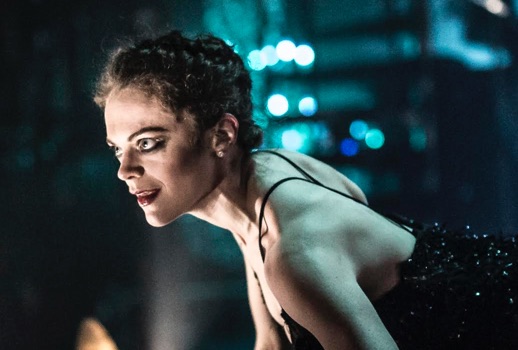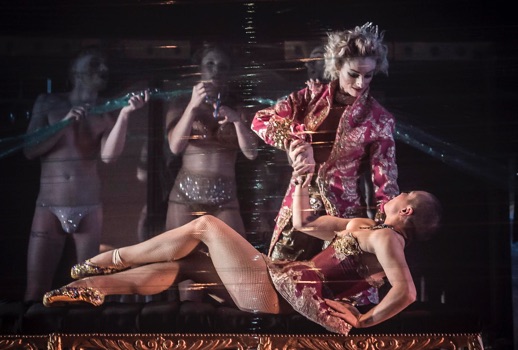

Despite being billed as dark, dangerous, and decadent, this Snow White keeps its childlike wonderment. While the cast wear what look like bejeweled dance belts, sparkly codpieces, pasties, and crotchless stockings, the partial nudity and overt sexuality (one must be 16 to gain entry) read not so much as edgy and provocative, but more as the stuff of fantasy and delight.
The performers dance, strut, sing, and mime Snow White’s narrative over the course of two hours with an infective self-abandon reminiscent of children playing dress-up in their mother’s closet; some members of the company even break into circus acrobatics to showcase pole dancing, ring and trapeze aerials, and a breathtaking Cyr wheel performance by Snow White’s Prince (Courtney Giannone). If there is danger to be found anywhere in this production, perhaps it looks like a sequined thong on a lady hanging upside down doing splits.
In the title role, dancer Hilly Bodin manages a sweet, self-contained innocence, working both en pointe and in an impressive array of glittery heels. In her role as Die Königen, Snow White’s vengeful stepmother, Laura Careless is virtuosic—bringing both comedy and tragedy to her dancing, yet never losing sight of the character’s interior life. Spellbinding to watch, Careless, a veteran member of the company who now also teaches at the New York Public School for Dance, brings both silent-screen pathos and broad humor to her role, turning in a performance that sometimes transcends the material.
A steady, sexy, and seemingly tireless corps of Showgirls (Marcy Richardson, Lea Helle and Mariso Cabrera) and Könilicher Hofstaat (Davon Rainey, Malik Shabazz Kitchen, Mark Odmunsen and Nicholas Katan as the Queen’s men) serve as the piece’s backbone, moving the drama along through spoken word, puppetry, dance, and song. Of these fantastic performers, Richardson stands out for her singing, with a voice that spans the taxing demands of Schubert, Handel, and Britney Spears. (“Toxic,” I must say, has never sounded so prim.) Also, in her role as the German Puppeteer, Helle is a cunning linguist, expertly maneuvering between spoken English and German, and nodding to the fairy tale’s deutschen Autoren, the Brothers Grimm.
And yet, despite these admirable performances, Snow White‘s success hinges on the vision of its director and choreographer, Austin McCormick. This graduate of The Conservatory of Baroque Dance and The Juilliard School judiciously exploits his source material’s universal themes, deploying idioms ranging from baroque opera to flamenco to burlesque.
The result is a kaleidoscope of dance and theater, by turns hectic, playful, excessive, and dazzling. Interweaving different fabrics of performance, both literally and figuratively, McCormick plunges his audience into spectacle, and serves up such tactile elements as lace, saran wrap, ice, frankincense, and the severe structuring of corsets. At one point we were snowed on. The brilliant set and costume designs by Zane Pihlstrom complement McCormick’s direction, and the deft lighting and projections by Jeanette Oi-Suk Yew bring a celestial, otherworldly quality to the proceedings.
However, what is most impressive about McCormick’s Snow White is the manner in which the director makes various idioms seem so organically cohesive, and ultimately convincing. While such far-flung quotations might come off as gimmicky and cheap in the hands of a less intelligent artist, McCormick’s tireless creativity keeps the production consistently watchable, and even fun.
With its flair for dramatic tableaux, his work calls to mind the choreography and stagecraft of Christopher Williams, an artist who similarly innovates by revisiting the past. However, McCormick’s artistic project lacks any sense of pretension, despite the modalities he engages in, because he is willing to entertain while relying on the high arts of history. Despite the pedigree of his allusions, McCormick’s Snow White is a fun, life-affirming night at the theater—a difficult art to master.
Photo: Mark Shelby Perry

























Comments